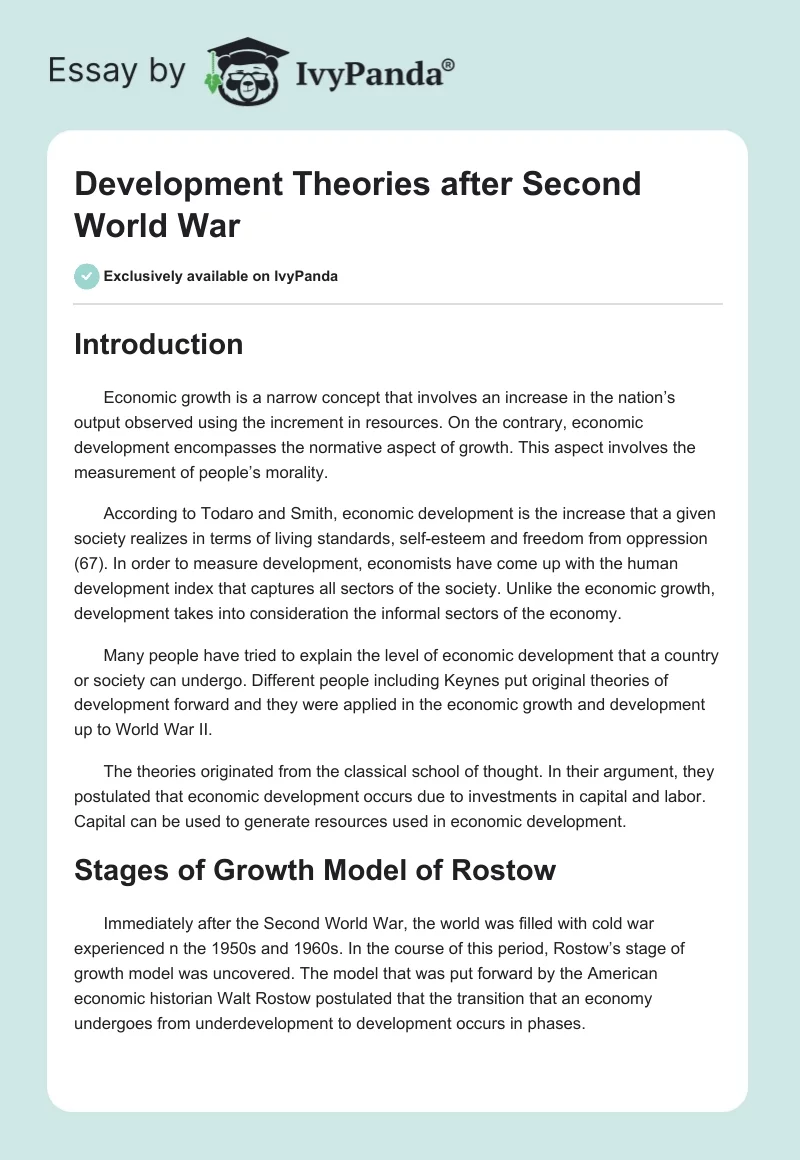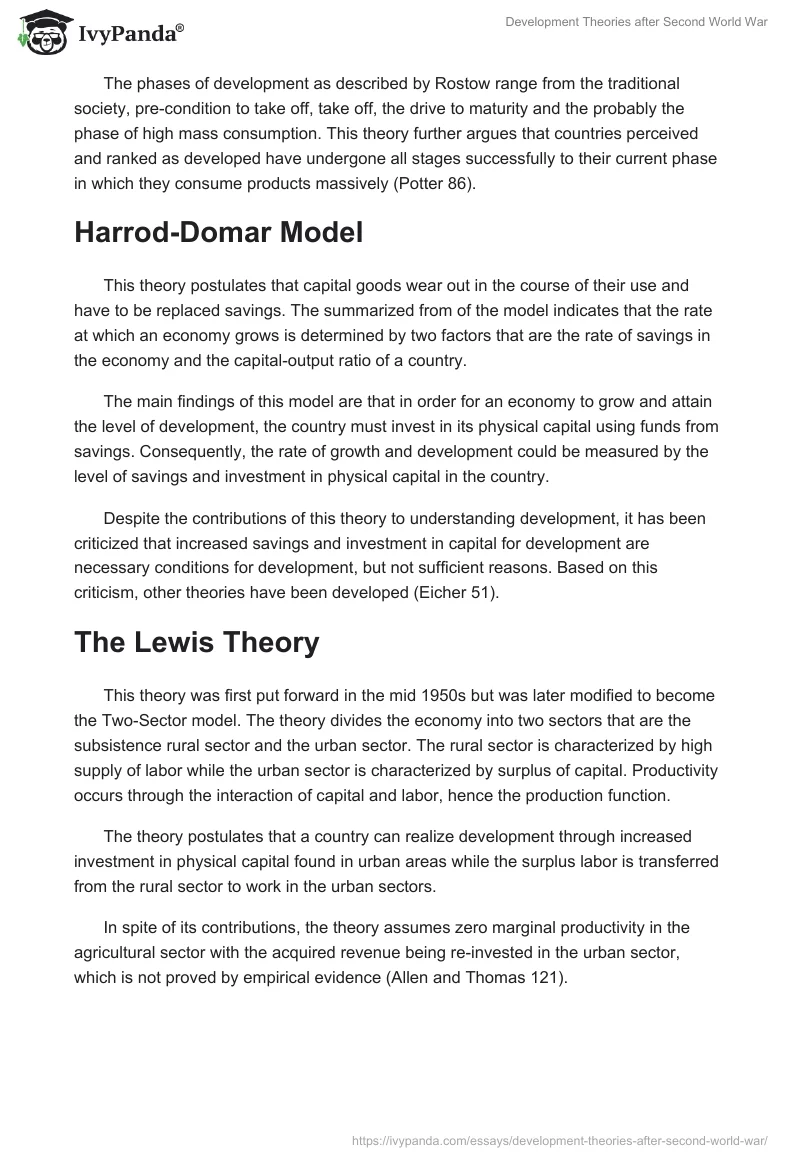Introduction
Economic growth is a narrow concept that involves an increase in the nation’s output observed using the increment in resources. On the contrary, economic development encompasses the normative aspect of growth. This aspect involves the measurement of people’s morality.
According to Todaro and Smith, economic development is the increase that a given society realizes in terms of living standards, self-esteem and freedom from oppression (67). In order to measure development, economists have come up with the human development index that captures all sectors of the society. Unlike the economic growth, development takes into consideration the informal sectors of the economy.
Many people have tried to explain the level of economic development that a country or society can undergo. Different people including Keynes put original theories of development forward and they were applied in the economic growth and development up to World War II.
The theories originated from the classical school of thought. In their argument, they postulated that economic development occurs due to investments in capital and labor. Capital can be used to generate resources used in economic development.
Stages of Growth Model of Rostow
Immediately after the Second World War, the world was filled with cold war experienced n the 1950s and 1960s. In the course of this period, Rostow’s stage of growth model was uncovered. The model that was put forward by the American economic historian Walt Rostow postulated that the transition that an economy undergoes from underdevelopment to development occurs in phases.
The phases of development as described by Rostow range from the traditional society, pre-condition to take off, take off, the drive to maturity and the probably the phase of high mass consumption. This theory further argues that countries perceived and ranked as developed have undergone all stages successfully to their current phase in which they consume products massively (Potter 86).
Harrod-Domar Model
This theory postulates that capital goods wear out in the course of their use and have to be replaced savings. The summarized from of the model indicates that the rate at which an economy grows is determined by two factors that are the rate of savings in the economy and the capital-output ratio of a country.
The main findings of this model are that in order for an economy to grow and attain the level of development, the country must invest in its physical capital using funds from savings. Consequently, the rate of growth and development could be measured by the level of savings and investment in physical capital in the country.
Despite the contributions of this theory to understanding development, it has been criticized that increased savings and investment in capital for development are necessary conditions for development, but not sufficient reasons. Based on this criticism, other theories have been developed (Eicher 51).
The Lewis Theory
This theory was first put forward in the mid 1950s but was later modified to become the Two-Sector model. The theory divides the economy into two sectors that are the subsistence rural sector and the urban sector. The rural sector is characterized by high supply of labor while the urban sector is characterized by surplus of capital. Productivity occurs through the interaction of capital and labor, hence the production function.
The theory postulates that a country can realize development through increased investment in physical capital found in urban areas while the surplus labor is transferred from the rural sector to work in the urban sectors.
In spite of its contributions, the theory assumes zero marginal productivity in the agricultural sector with the acquired revenue being re-invested in the urban sector, which is not proved by empirical evidence (Allen and Thomas 121).
The Solow Growth Model
There is a close link between economic growth and development as sustainable economic growth results into economic development. Despite the contribution that the classical and traditional theories of development contributed to the discipline, modern theories put forward some interesting revelations.
One of the modern theories of development is the Solow Growth model. This theory has included changes in technology into the model of growth and development. Therefore, it postulates that development is a factor of capital, labor and technological advances (North 210).
According to Potter, the Solow model incorporates the importance of knowledge and technology into the model of development (109). Therefore, the production function assumes constant returns to scale.
It can be deduced from the model that long-term growth of an economy requires application of knowledge and technology and not only labor and capital. From this survey, it is evident that the theories of development have changed over time beginning from the Second World War.
While earlier theories only considered capital and labor, neo-classical development theories factored in technology in the achievement of economic growth and development.
In addition, earlier theories insisted in investment in physical capital using savings as major factors for development. However, later theories have emphasized the importance of investing in knowledge and technology apart from capital as necessary and sufficient development conditions.
Works Cited
Allen, Tim and Thomas, Allan. Poverty and Development into the 21st century. Oxford: Oxford University Press. 2000. Print.
Eicher, Staatz. International Agricultural Development. 3rd edn. Baltimore: The Johns Hopkins University Press. 1998. Print.
North, Douglas. Structure and Change in Economic History. London: W.W Norton & Company. 1981. Print.
Potter, Robert, et al. Geographies of Development, An introduction to Developments Stuides. 3rd ed. Harlow: Pearson, Prentice Hall. 2008. Print.
Todaro, Michael and Smith, Stephen. Economic Development. 10th edn. Addison-Wesley. 2009. Print.


